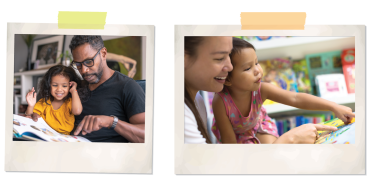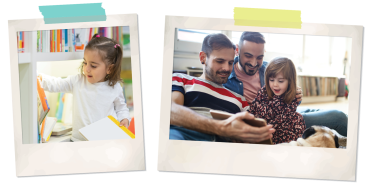Young children’s development takes place across multiple strands—such as physical skills, like learning to hold a crayon, and social skills, like learning to have back-and-forth conversations. All of these strands weave together to support readiness for literacy and other academic learning. Although every child is unique, there are some common things that you as a parent or caregiver can look for within each of these strands when your child is three to five years old. This way, you can seek professional guidance and support if you are concerned about an area of your child’s development.
Preparing your child to thrive in preschool, kindergarten, and beyond includes finding out if they are on track in their physical development. Check on your child’s overall health. Then, think specifically about their eyes, ears, hands, and feet! Be sure to work with a doctor, nurse, or other specialist to see whether your child’s vision, hearing, and motor skills are all developing typically.
Another important strand of early development is social engagement with others. Your child should be sharing their interests with you by pointing, bringing you things to look at, or initiating a topic of conversation. They also should respond (most of the time, if not always) when you call their attention to something that you find interesting. If this does not sound like the way your child engages with you and others, then it may be a good idea to schedule a developmental screening for them. To complete this screening, contact your local public school district or locate your state’s specific version of the national Child Find program, which you can learn about here. A screening is the first step in identifying developmental disabilities—and getting the services your child may need. Another great source of guidance and resources is at autismnavigator.com.
The next strand to check on is your child’s language development. Language development is critical for literacy development, especially for being able to understand what you read. Language development is also highly connected to successful progress in other academic areas, such as math and science. Plus, strong communication skills are important for the development of strong social skills. There are some questions you can ask about your child’s language development to see if they are on track in the preschool to kindergarten period.
- Can people who do not know your child understand their speech? By three years old, most of what your child says should be clear, even to strangers who are not used to hearing your child speak. This does not mean that they pronounce all words and all sounds correctly all the time. It takes many children longer to clearly pronounce some sounds, like /th/, /r/, and /l/.
- Can your child follow two- or three-step directions? Of course, children do not always do everything their families ask them to do, but your child should usually be able to follow a short sequence of directions when you ask them to. For example, they should complete both parts of “put on your shoes and come to the door” in the right order. Not sure what your child can do? Play some games for following directions with your child during routines like getting dressed, having a meal, and getting ready for bed.
- Does your child speak in complete sentences using a variety of words? By age four, you should hear your child say sentences that include a large variety of nouns (people, places, and things) and verbs (actions). In addition, four-year-olds (and especially five-year-olds) should be including words to describe the color, shape, size, speed, and timing of the objects and actions they are talking about. You might hear: “Jaden has the green ball,” “Sofia built the biggest tower,” “I ate the cookie quickly,” or “We walked the dog before school.”
- Can your child tell you a simple story? Storytelling is another window into the language skills that are so important for listening comprehension and later reading comprehension. Telling stories is one way that children demonstrate their ability to talk about the past or future, rather than just about what is happening right now. By age four, most children can make up a basic narrative that includes one or more characters and what happens to them. Some children’s stories might include where and why events take place. If your child does not usually share their own real or make-believe stories with you, then tell them a story or read one aloud to them and see how well they can tell it back to you.
Now, let’s focus on skills that are specific to learning to read. There are some very important early literacy skills that help children learn to “crack the code” of reading text. When children are stronger in these early literacy skills, formal reading instruction in kindergarten and first grade will make more sense. There are some questions you can ask about your child’s skill development to see if they are on track.
- Does your child know the names and sounds of the letters? Children who begin kindergarten already knowing some of the letters in the alphabet will have an easier time learning to read. Many children learn the letters in their own name first, so you may want to see if your child can recognize and write their name. Name writing before kindergarten is a good predictor of later reading success.
- Can your child identify and play with the sounds in simple words? Words are made up of individual sounds. For example, the word pot has three sounds (/p/, /o/, and /t/), and the words pot, pig, and pan all have the same first sound. Children who recognize that words are made up of sounds and can play around with words’ sounds have an easier time learning to read. Check to see if your child can put sounds together, such as blending nap and kin to say napkin. Your child should also learn to separate sounds, such as breaking picnic into pic and nic. And, try playing with the sounds in words by leaving sounds off, such as taking /d/ off of card to say car.
To learn to read, children have to combine their letter knowledge and sound awareness to transform written words into spoken words. Then, they will draw on their language skills to understand the words and sentences they are reading. If you have concerns about your child’s progress in one or more of these developmental strands, there is plenty that you can do to help them. One of the first things to do is to talk to the teachers at your child’s preschool or elementary school. These educators can be a fantastic source of information and support for you.
Beth M. Phillips is a professor of Educational Psychology and Learning Systems and an associate director of the Florida Center for Reading Research at Florida State University.
[photos: Getty Images]



